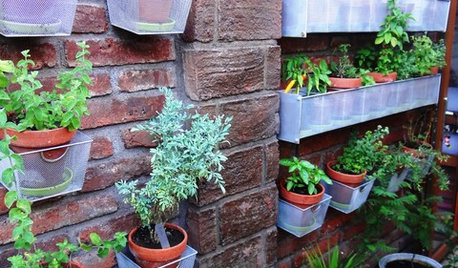To wayne 5 on potato info
hobbiest
11 years ago
Related Stories

DINING ROOMS5 Instant Dining Tables
Company coming? These console tables expand into a party-sized dinner table
Full Story
KITCHEN DESIGNKitchen Recipes: Secret Ingredients of 5 One-of-a-Kind Cooking Spaces
Learn what went into these cooks’ kitchens — and what comes out of them
Full Story
EVENTSColors and Patterns Wow at the 2015 Kips Bay Decorator Show House
Go on a virtual tour as 22 designers put on a beautiful interior fashion show in NYC’s Arthur Sachs mansion
Full Story
HEALTHY HOME12 Ways to Set Up Your Kitchen for Healthy Eating
Making smart food choices is easier when your kitchen is part of your support team
Full Story
SPRING GARDENINGSummer Crops: How to Grow Strawberries
Pluck your own sweet strawberries right from the garden vine for smoothies, salads or eating then and there
Full Story
EVENTSTreasure Hunting at Texas' First Monday Trade Days
Check out some of the antiques, art and collectibles on offer at one of the largest flea markets in the U.S.
Full Story
INSPIRING GARDENSWhat We Can Learn From Longwood Gardens’ New Meadow
Sustainability, ecology, native plant communities ... this public garden is brimming with lessons on horticulture for home gardeners
Full Story
GARDENING GUIDES9 Fresh Herbs for Crowd-Pleasing Thanksgiving Dishes
Pluck these herbs from a windowsill pot or a garden for a Thanksgiving meal that sings with fresh flavor
Full Story
MOST POPULARHow to Create an Inventory, Whether You're Naturally Organized or Not
Documenting your home items is essential, even if disaster seems unimaginable. And it may be easier than you think
Full Story
MOST POPULAR7 Ways to Design Your Kitchen to Help You Lose Weight
In his new book, Slim by Design, eating-behavior expert Brian Wansink shows us how to get our kitchens working better
Full Story






jonfrum
hobbiestOriginal Author
Related Professionals
Parole Landscape Architects & Landscape Designers · Williamsburg Landscape Contractors · Ashburn Landscape Contractors · Battle Ground Landscape Contractors · Edinburg Landscape Contractors · Framingham Landscape Contractors · Marlborough Landscape Contractors · Olympia Landscape Contractors · Paramus Landscape Contractors · Whittier Landscape Contractors · Maple Heights Landscape Contractors · Cheshire Gardeners & Lawn Care · Ashburn Driveway Installation & Maintenance · Cincinnati Driveway Installation & Maintenance · Cleveland Driveway Installation & Maintenancepnbrown
wayne_5 zone 6a Central Indiana
hobbiestOriginal Author
hobbiestOriginal Author
RpR_
wayne_5 zone 6a Central Indiana
pnbrown
bart1
pnbrown